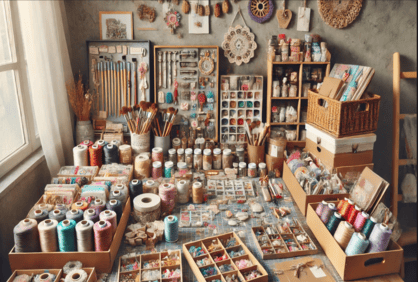Craft kits are a fantastic way to attract customers who want to explore their creativity but don’t know where to start. Offering ready-made kits with materials and detailed instructions not only simplifies the process for beginners but also creates a lucrative business opportunity. Here’s a complete guide to creating and selling craft kits.
1. Choose the Type of Craft
The first step is deciding which type of craft your kit will focus on. Some popular ideas include:
- Macramé: Kits for creating plant hangers or decorative wall panels.
- Jewelry: Materials to make necklaces, bracelets, or earrings.
- Sewing: Kits for making simple pillows, tote bags, or decorative items.
- Painting: Sets with canvases, brushes, and paints.
- Paper Crafts: Kits for scrapbooking or creating custom cards.
2. Gather High-Quality Materials
Use durable and high-quality supplies to ensure customer satisfaction.
- Choose Reliable Suppliers: Source materials in bulk to reduce costs.
- Focus on Variety: Include a range of colors, textures, and tools in your kits.
- Consider Sustainability: Use eco-friendly materials to appeal to environmentally conscious customers.
3. Include Clear Instructions
Make your kits beginner-friendly with step-by-step guides.
- Detailed Instructions: Provide written or illustrated guides that are easy to follow.
- Video Tutorials: Offer QR codes linking to video demonstrations for added value.
- Language Options: If selling internationally, consider offering instructions in multiple languages.
4. Design Attractive Packaging
Your kit’s packaging is the first thing customers will notice, so make it appealing.
- Use Branding: Include your logo, colors, and contact information on the packaging.
- Keep It Practical: Ensure the packaging is sturdy and protects the contents.
- Eco-Friendly Options: Use recyclable or biodegradable materials to stand out.
5. Price Your Kits Competitively
Determine a price that covers your costs and appeals to your target audience.
- Calculate Costs: Include materials, packaging, and labor in your pricing.
- Research Competitors: Check what similar kits are selling for.
- Offer Discounts: Provide bundle deals or introductory prices to attract first-time buyers.
6. Promote Your Kits
Use multiple channels to market your craft kits.
- Social Media: Share photos, videos, and customer reviews on platforms like Instagram and Facebook.
- E-Commerce Platforms: List your kits on Etsy, Amazon Handmade, or your own website.
- Craft Fairs: Sell your kits at local events to reach a broader audience.
7. Gather Feedback
Listen to your customers to improve your kits.
- Ask for Reviews: Encourage buyers to leave feedback or share photos of their finished projects.
- Analyze Trends: Note which kits are most popular and adjust your offerings accordingly.
- Offer Support: Be available to answer questions and help customers with their projects.
Conclusion: Inspire Creativity
Creating and selling craft kits is a rewarding way to share your passion for crafting while helping others discover their creativity. With high-quality materials, clear instructions, and thoughtful packaging, you can create kits that stand out and delight your customers. Start designing your craft kits today and watch your business grow!

